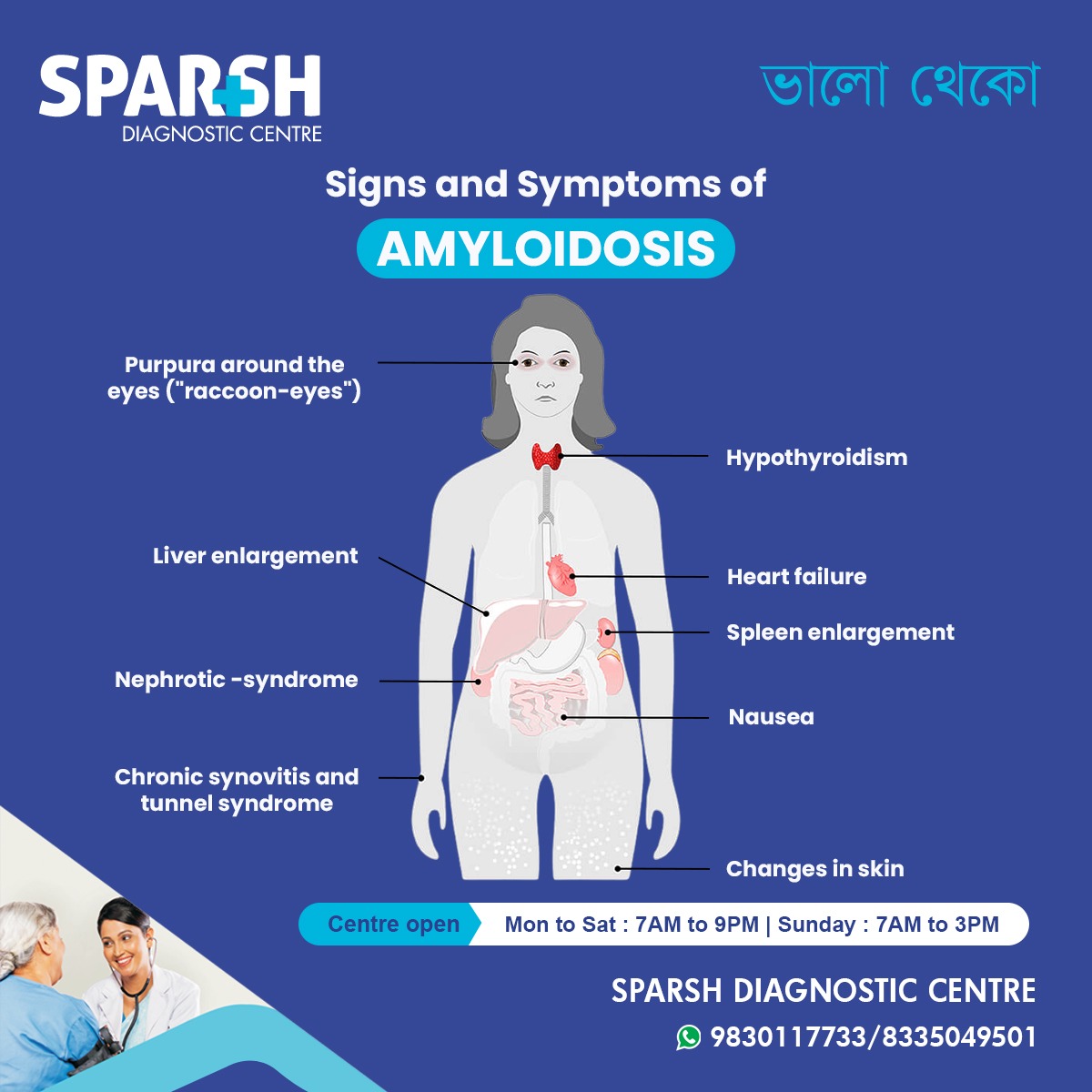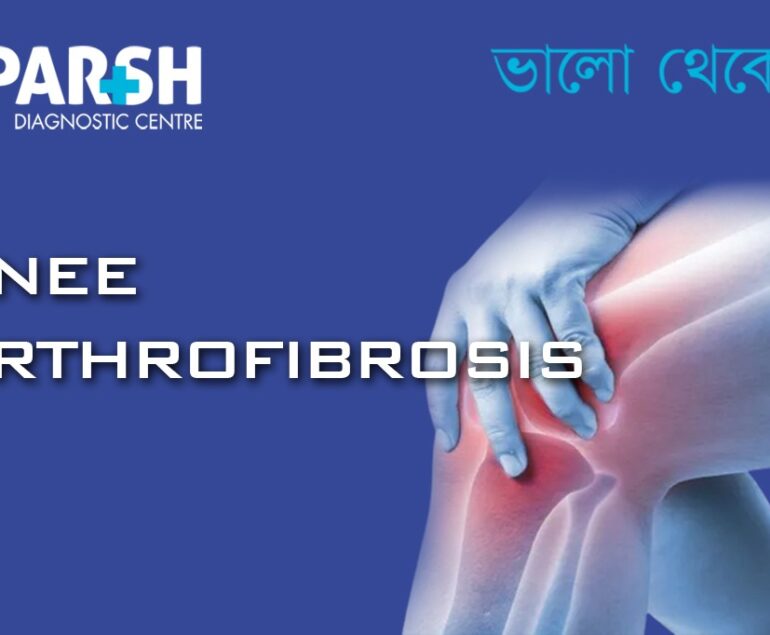Amyloidosis is a rare but serious condition that occurs when abnormal proteins—called amyloids—accumulate in tissues and organs, disrupting their normal function. It can affect a wide range of organs, including the heart, kidneys, liver, spleen, nervous system, and digestive tract.
Though uncommon, amyloidosis requires early detection and targeted treatment, as it can lead to organ failure and severe complications. This in-depth guide will help you understand the condition, including its types, causes, symptoms (as shown in the Sparsh infographic), diagnostic methods, and treatment options.
What is Amyloidosis?
Amyloidosis is a group of diseases characterized by the accumulation of misfolded amyloid proteins in various tissues and organs. These proteins, which are normally soluble, become insoluble and deposit in organs like the heart, kidneys, liver, spleen, and nervous system, impairing their normal function.
Types of Amyloidosis
There are several types of amyloidosis, classified based on the protein involved:
1. AL (Light Chain) Amyloidosis
The most common form in developed countries.
Caused by abnormal plasma cells producing excess light chains (a type of antibody).
Often associated with multiple myeloma.
Organs affected: kidneys, heart, liver, nervous system.
2. AA (Secondary) Amyloidosis
Occurs due to chronic inflammatory conditions like rheumatoid arthritis, tuberculosis, or Crohn’s disease.
Protein involved: Serum Amyloid A.
Organs affected: kidneys, liver, spleen.
3. ATTR (Transthyretin) Amyloidosis
Caused by deposits of abnormal transthyretin protein, made in the liver.
Two types:
Hereditary ATTR (hATTR): Inherited mutation.
Wild-type ATTR: Occurs in older adults, often affects the heart.
4. Dialysis-Related Amyloidosis
Seen in long-term dialysis patients.
Protein involved: β2-microglobulin.
Commonly affects bones, joints, and tendons.
Causes and Risk Factors
Amyloidosis is not always inherited; many forms are acquired. Common risk factors include:
Chronic inflammatory diseases (rheumatoid arthritis, IBD)
Chronic infections (tuberculosis, osteomyelitis)
Plasma cell disorders (multiple myeloma)
Long-term dialysis
Age > 60
Family history of amyloidosis
Certain genetic mutations (in hereditary ATTR)
Signs and Symptoms of Amyloidosis
Amyloidosis symptoms depend on the organs affected. The infographic from Sparsh Diagnostic Centre highlights the most common signs:
1. Purpura Around the Eyes (“Raccoon Eyes”)
Dark circles or bruises around the eyes without trauma.
Due to amyloid deposition weakening capillaries.
2. Hypothyroidism
Amyloid deposition in the thyroid gland can lead to underactive thyroid.
Symptoms: fatigue, weight gain, dry skin, cold intolerance.
3. Heart Failure
Infiltration of amyloid proteins stiffens the heart muscle (restrictive cardiomyopathy).
Symptoms: shortness of breath, swelling in legs, fatigue, palpitations.
4. Liver Enlargement (Hepatomegaly)
May cause abdominal fullness, discomfort, or elevated liver enzymes.
5. Spleen Enlargement (Splenomegaly)
May lead to low platelet count, anemia, and abdominal discomfort.
6. Nephrotic Syndrome / Kidney Damage
One of the most common and serious manifestations.
Symptoms: foamy urine, swelling in legs, proteinuria, kidney failure.
7. Nausea and Digestive Issues
Amyloid deposits in the gastrointestinal tract may cause nausea, diarrhea, constipation, or malabsorption.
8. Chronic Synovitis and Carpal Tunnel Syndrome
Joint pain and swelling due to amyloid infiltration.
Carpal tunnel symptoms: numbness, tingling, and pain in the hands.
9. Skin Changes
Easy bruising, waxy thickening of the skin, or lumps under the skin.
10. Neurological Symptoms
Peripheral neuropathy: tingling, numbness, or pain in hands and feet.
Autonomic dysfunction: low blood pressure, dizziness, GI motility issues.

Complications of Amyloidosis
Gastrointestinal bleeding
Severe hypotension (especially postural)
Respiratory difficulty (due to lung involvement)
Malnutrition and weight loss
Diagnosis of Amyloidosis
1. Medical History and Physical Examination
Doctors look for clinical clues like unexplained swelling, fatigue, or weight loss, especially in high-risk patients.
2. Laboratory Tests
Urinalysis for proteinuria (sign of nephrotic syndrome).
Blood tests for liver and kidney function.
Serum and urine protein electrophoresis (SPEP/UPEP) to detect monoclonal light chains.
Serum free light chain assay.
Genetic testing (for hereditary ATTR).
3. Biopsy
Tissue biopsy (fat pad, kidney, rectum, or organ-specific) is stained with Congo red, which shows apple-green birefringence under polarized light—a hallmark of amyloid.
4. Imaging Studies
Echocardiography: To detect restrictive cardiomyopathy.
MRI/CT scan: Assessing organ enlargement.
Scintigraphy (SAP scan or DPD scan): Detects amyloid deposits.
5. Bone Marrow Biopsy
Used in AL amyloidosis to evaluate plasma cell abnormalities.
Treatment of Amyloidosis
Treatment depends on the type and extent of organ involvement.
1. AL Amyloidosis
Chemotherapy (similar to multiple myeloma regimens): cyclophosphamide, bortezomib, dexamethasone (CyBorD).
Autologous stem cell transplant in eligible patients.
Monoclonal antibodies like daratumumab.
2. AA Amyloidosis
Treat the underlying inflammatory disease (e.g., RA or TB).
Use of biologics (e.g., TNF inhibitors) to reduce inflammation.
Colchicine in certain cases.
3. ATTR Amyloidosis
Liver transplant (for hereditary types).
Tafamidis – stabilizes transthyretin and slows disease progression.
Patisiran and Inotersen – RNA interference therapies that reduce TTR production.
4. Dialysis-Related Amyloidosis
Optimize dialysis efficiency.
Kidney transplant in selected cases.
Use of beta-2 microglobulin filtration techniques.
Supportive Treatments
Regardless of type, the following may help improve quality of life:
Diuretics for fluid retention.
ACE inhibitors or ARBs for kidney protection.
Pain management for neuropathy.
Physical therapy for joint issues.
Nutritional support for weight loss and malabsorption.
Pacemakers for heart rhythm abnormalities.
Compression stockings for hypotension.
Lifestyle and Monitoring
Regular Follow-ups
Frequent check-ups are essential to monitor organ function and treatment response.
Low-Sodium, High-Protein Diet
Helpful for kidney and heart involvement.
Hydration and Electrolyte Balance
Especially important in those with autonomic symptoms or GI losses.
Infection Prevention
Vaccinations and hand hygiene, especially in immunosuppressed patients.
Prognosis
The outlook depends on:
Type of amyloidosis
How many organs are affected
How early the condition is diagnosed
AL Amyloidosis:
Prognosis is poor without treatment; survival can improve significantly with early diagnosis and therapy.
ATTR Amyloidosis:
Slower progression in wild-type ATTR; newer drugs (like tafamidis) show promise in improving outcomes.
AA Amyloidosis:
Prognosis improves dramatically with successful control of the underlying inflammatory disease.
Prevention and Early Detection
While not all forms are preventable, early intervention can prevent irreversible organ damage. People with the following conditions should undergo routine screening for amyloidosis:
Multiple myeloma or MGUS
Chronic inflammatory diseases
Family history of amyloidosis
Unexplained proteinuria or organ dysfunction
Amyloidosis at a Glance
| Feature | Details |
|---|---|
| Definition | Abnormal amyloid protein buildup in organs |
| Common Organs Affected | Kidneys, heart, liver, nerves, spleen |
| Main Symptoms | Swelling, fatigue, neuropathy, heart failure |
| Diagnostic Tools | Biopsy, blood/urine tests, imaging |
| Treatment | Chemotherapy, gene therapy, organ transplant |
| Prognosis | Varies by type and treatment timing |
When to See a Doctor
Consult a healthcare provider if you experience:
Unexplained swelling (especially legs)
Foamy urine or sudden kidney issues
Persistent fatigue or shortness of breath
Weight loss without trying
Numbness or tingling in extremities
Early diagnosis can significantly improve outcomes.
Amyloidosis is a complex and often underdiagnosed condition with potentially serious consequences. However, advancements in diagnostics and treatment options have improved survival and quality of life for many patients.
If you or someone you know is experiencing symptoms consistent with amyloidosis—or has a related chronic condition—it’s important to seek timely medical evaluation. Multidisciplinary care, including nephrology, cardiology, and hematology, can be life-saving.
Need Help?
At Sparsh Diagnostic Centre, we offer:
Comprehensive blood and urine tests
Ultrasound and imaging services
Biopsy services
Cardiac evaluations
Specialist consultations
📞 Call us at 9830117733 / 8335049501
🌐 Visit: www.sparshdiagnostica.com
#BhaloTheko
Disclaimer:
No content on this site, regardless of date, should ever be used as a substitute for direct medical advice from your doctor or other qualified clinician.

![]()






[…] Amyloidosis […]